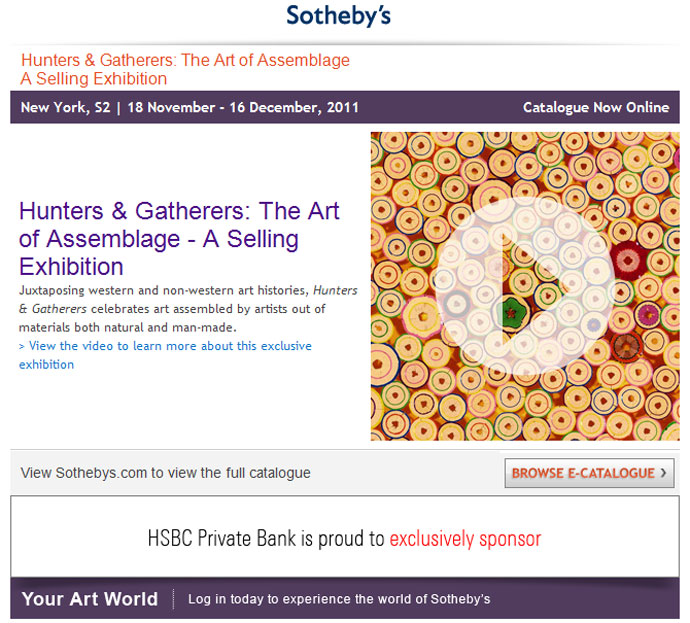Sotheby’s New York – Hunters & Gatherers: The Art of Assemblage – A Selling Exhibition
November 22nd, 2011 by adminFor enquiries please contact:
Lisa Dennison, Lisa.Dennison@sothebys.com, +1 212 894 1424
Lara Barak, Lara.Barak@sothebys.com, +1 212 894 1577
For most of history, human beings were hunters and gatherers. Until the invention of agriculture, about 10,000 years ago, to subsist meant to comb the wilds, foraging for edible plants and animals. The impulse to scavenge is thus embedded in our genes, and through the centuries it has found powerful expression in the world of art.
Artists are a particular type of hunter-gatherers. Since ancient times, they have assembled works from assorted materials, both natural and man-made, in arrangements in which the artistic whole transcends the sum of its parts.
The focus of this exhibition is the accumulative tendency in art that has been broadly labeled as “assemblage.” Much of the work in this realm before the 20th century has been the product of artists from pre-Columbian America, Africa and Oceania. From the 17th century, Native Americans actively traded with Europeans for precious commodities such as metal and glass beadwork, which they ingeniously incorporated into ceremonial items, clothing and weaponry. These decorations conveyed status and added luster and allure to a wide range of objects including masks, rattles and headdresses.
During the same period, a rich sculptural tradition emerged on the other side of the globe, in the Chiloango River Region in central Africa. Power figures, carved of wood in human or animal form, were used to harness spiritual forces for protection, healing or revenge. A ritual expert drove metal objects into the figure to awaken the spirit. The potent physical presence of these figures, bristling with nails, blades and spikes, still resonates with the power of these awe-inspiring rituals.
In the early 20th century, African artworks began to arrive in Europe, catalyzing a seismic shift in the course of western art history. They had a profound influence on many artists, including Picasso and Braque, who were soon to create an artistic revolution of their own, when they inserted fragments of the real world onto the surface of their canvases, heralding the advent of collage. Building on these innovations, Dada and Surrealist artists such as Marcel Duchamp, Man Ray and Kurt Schwitters exploited the collision of the rational and non-rational through the use of readymade objects and the chance arrangements of forms. Neo-Dada and Pop artists also incorporated found and manufactured objects into their art; in his Combines, Robert Rauschenberg expressed the desire to bridge the gap between art and life.
The practice of assemblage has continued into the 21st century, with artists enthusiastically using non-traditional materials in both intimate and environmentally-scaled artworks. Many of these follow the cooler conceptual strategies of Duchamp, while others mine Africa’s heritage, not only in the sense of formal properties, but by tapping into their cultural, social and historical resonance as well. Nick Cave, for example, explores issues of ceremony and ritual in his beautifully crafted Soundsuits, referencing both tribal and Indian art in their various guises. El Anatsui stitches together mesmerizing metal tapestries out of recycled liquor bottle caps. Others, including Anselm Kiefer and Huma Bhaba, incorporate clay and other natural materials into their paintings and sculpture.
Juxtaposing western and non-western art histories, this exhibition is itself an assemblage of different time periods, cultures and artistic forms, resulting in striking visual encounters. In some cases, there is a direct reference to the notion of hunting and gathering, while in others, materials are recuperated into hybrid compositions that are playful, enigmatic and dynamic. Ultimately, it is the fluidity of ideas and the dialogues between objects that create the universe of Hunters and Gatherers.

